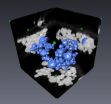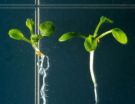(Press-News.org) ANN ARBOR, Mich. — When it comes to gene sequencing and personalized medicine for cancer, spotting an aberrant kinase is a home run. The proteins are relatively easy to target with drugs and plenty of kinase inhibitors already exist.
Now in a new study, University of Michigan Comprehensive Cancer Center researchers assess the complete landscape of a cancer's "kinome" expression and determine which kinases are acting up in a particular tumor. They go on to show that those particular kinases can be targeted with drugs – potentially combining multiple drugs to target multiple kinases.
"We have a small but effective inventory of 'druggable' mutations that we know play a role in cancer. As we are doing more sequencing, we're coming to realize just how small that inventory is. On the one hand, it's a limitation. On the other hand, there are numerous oncogenic kinases, and there are a lot of kinase inhibitors. Our goal is to determine how to match more of these therapies with the right patients," says senior study author Chandan Kumar-Sinha, Ph.D., research assistant professor at the Michigan Center for Translational Pathology.
The researchers looked at RNA sequencing data from 482 samples of both cancerous and non-cancerous tissue and identified the most highly expressed kinases in individual breast cancer and pancreatic cancer samples. They found certain common themes.
"A lot of samples showed one or two kinases that showed an outstandingly high 'outlier' expression," says Kumar-Sinha. It wasn't that the researchers always found a mutation – just that one or more kinases were expressed at a far higher level than all other kinases.
"We don't always know what's causing it to be overexpressed. But since it's there, we know that somehow the high expression of oncogenic kinases is advantageous to the cancer, and so we can therapeutically exploit that dependency," Kumar-Sinha says.
Results of the study appear online in the journal Cancer Discovery.
In breast cancer, the researchers spotted outlier expression of ERBB2 kinase in HER2-positive tumors, which would be expected. HER2-positive tumors can be treated with Herceptin. But they also found another kinase, called FGFR4 – and they found that adding a drug that blocks FGFR4, in combination with Herceptin, improved the anti-cancer effect. This was done only in cells in the laboratory, but the FGFR4-inhibitor continued to be effective in cells even after they became resistant to Herceptin.
In the pancreatic cancer samples, the researchers found several different kinases that have drugs that work against them, including MET, AKT and PLK. Pancreatic cancer is one of the most deadly types of cancer, often diagnosed in its late stages when treatments are not very effective. The main driver of pancreatic cancer, a mutation in a gene called KRAS, has proven difficult to target with treatments.
In the lab, researchers blocked the outlier kinases and found it had an effect against the cancer cells. They then blocked KRAS – something that can be done in the lab but has not been achieved in patients with pancreatic cancer – and found an even larger effect.
"If in the future we could target KRAS in patients and also hit the outlier kinases, it could have a huge impact on treatment of pancreatic cancer," Kumar-Sinha says.
These findings must still be tested in patients, but researchers are hopeful that targeting specific kinases expressed in an individual patient's tumor could make a difference.
The U-M Comprehensive Cancer Center is currently using gene sequencing techniques to help match advanced cancer patients with potential clinical trial opportunities based on the make-up of their tumor.
"We hope kinases will represent another available avenue with whole genome sequencing. If we can identify rational multiple targets for treatment, it's more effective. This gets us one of those targets," Kumar-Sinha says.
###
Additional authors: Vishal Kothari, Iris Wei, Sunita Shankar, Shanker Kalyana-Sundaram, Lidong Wang, Linda W. Ma, Pankaj Vats, Catherine S. Grasso, Dan R. Robinson, Yi-Mi Wu, Xuhong Cao, Diane M. Simeone, Arul M. Chinnaiyan, all from U-M
Funding: National Cancer Institute grants 5-R21-CA-155992-02, 2T32CA009672-21, R01CA131045-01, P50CA130810-1A; Department of Defense Era of Hope grant BC075023; Rich Rogel Fund for Pancreatic Cancer Research; Doris Duke Charitable Foundation; American Cancer Society; U-M's A. Alfred Taubman Research Institute; U-M GI SPORE
Disclosure: None
Reference: Cancer Discovery, "Outlier Kinase Expression by RNA Sequencing as Targets for Precision Therapy," published online Feb. 5, 2013, doi:10.1158/2159-8290.CD-12-0336
Resources:
U-M Cancer AnswerLine, 800-865-1125
U-M Comprehensive Cancer Center, www.mcancer.org
Clinical trials at U-M, www.UMClinicalStudies.org/cancer
END
WEST LAFAYETTE, Ind. – Researchers are improving the performance of technologies ranging from medical CT scanners to digital cameras using a system of models to extract specific information from huge collections of data and then reconstructing images like a jigsaw puzzle.
The new approach is called model-based iterative reconstruction, or MBIR.
"It's more-or-less how humans solve problems by trial and error, assessing probability and discarding extraneous information," said Charles Bouman, Purdue University's Michael and Katherine Birck Professor of Electrical and Computer ...
EurekAlert!'s most-viewed news release from 2012 focused on a breakthrough in the treatment of obesity and related diseases using a combination of hormones, tested in mice, that resulted in weight loss and lowered blood sugar without negative side effects.
The theme of obesity was prominent in three other most-viewed news releases on EurekAlert! during 2012.. Other topics were mental health, neuroscience, marine conservation, human behavioral science, and progress toward a male contraceptive pill.
EurekAlert! is the global science news service operated by the American ...
A pair of commentaries to appear in an upcoming issue of the journal Antimicrobial Agents and Chemotherapy highlight a debate within the public health community surrounding Centers for Disease Control and Prevention (CDC) recommendations for treatment of exposed individuals during last year's fungal meningitis outbreak. Manuscripts of the commentaries were published ahead of print today on the journal's webpage.
"I will try to offer sufficient documentation to show there are alternative approaches worthy of consideration," writes David A Stevens of Stanford University ...
Ever since Austrian scientist Erwin Schrodinger put his unfortunate cat in a box, his fellow physicists have been using something called quantum theory to explain and understand the nature of waves and particles.
But a new paper by physics professor Andreas Albrecht and graduate student Dan Phillips at the University of California, Davis, makes the case that these quantum fluctuations actually are responsible for the probability of all actions, with far-reaching implications for theories of the universe.
Quantum theory is a branch of theoretical physics that strives ...
LA JOLLA, CA----You might think you have nothing in common with mustard except hotdogs. Yet based on research in a plant from the mustard family, Salk scientists have discovered a possible explanation for how organisms, including humans, directly regulate chemical reactions that quickly adjust the growth of organs. These findings overturn conventional views of how different body parts coordinate their growth, shedding light on the development of more productive plants and new therapies for metabolic diseases.
Metabolism refers to all the chemical reactions in the body ...
The vast edges of our solar system – the boundary at the edge of our heliosphere where material streaming out from the sun interacts with the galactic material – is essentially invisible. It emits no light and no conventional telescope can see it. However, particles from inside the solar system bounce off this boundary and neutral atoms from that collision stream inward. Those particles can be observed by instruments on NASA's Interstellar Boundary Explorer (IBEX). Since those atoms act as fingerprints for the boundary from which they came, IBEX can map that boundary in ...
HOUSTON – (February 5, 2013) – American Indians are at much greater risk of suicide after acute alcohol intoxication, according to a study led by researchers at The University of Texas Health Science Center at Houston (UTHealth).
The study examined the prevalence and social demographic correlates of suicide involving acute alcohol intoxication among United States ethnic minorities. Results will be published in the May 2013 issue of Alcoholism: Clinical & Experimental Research and are currently available at Early View.
"Some reviews suggest that people with alcohol ...
An allergic reaction to cockroaches is a major contributor to asthma in urban children, but new research suggests that the insects are just one part of a more complex story. Very early exposure to certain components of air pollution can increase the risk of developing a cockroach allergy by age 7 and children with a common mutation in a gene called GSTM may be especially vulnerable.
Researchers at the Columbia Center for Children's Environmental Health at the Mailman School of Public Health published the findings, the first on this interplay of risk factors, in the February ...
Mothers who are exposed to particulate air pollution of the type emitted by vehicles, urban heating and coal power plants are significantly more likely to bear children of low birth weight, according to an international study led by co-principal investigator Tracey J. Woodruff, PhD, MPH, professor of obstetrics and gynecology and reproductive sciences at UC San Francisco along with Jennifer Parker, PhD, of the National Center for Health Statistics, Centers for Disease Control and Prevention.
The study, the largest of its kind ever performed, analyzed data collected from ...
After a year of studying up close the symbiotic relationship between a mosquito-sized bug and a fungus, a Simon Fraser University biologist has advanced the scientific understanding of biological diversity.
Jeffrey Joy has discovered that symbiosis — a relationship between two or more organisms that can be parasitic or mutualistic — is as much the mother of biological diversity as predation and competition.
The Proceedings of the Royal Society of London Series B journal has just published the post-doctoral researcher's findings online. They advance Joy's previous ...



